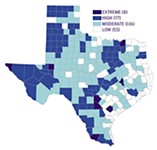Cap Metro: The Quarter Cent Shuffle
Why Cap Metro takes a quarter-cent and then gives it back
By Katherine Gregor, Fri., April 16, 2010
The answer is politics – specifically, road vs. rail politics. In 2000, when light rail lost narrowly at the polls, the Capital Metro board was under mounting road-warrior and legislative pressure to return the quarter-cent in sales tax it had been setting aside for the light rail project. (Although a slim majority of voters within the city of Austin – 50.6% – voted in favor of Cap Metro's light rail plan, it lost in the overall Cap Metro service area by about 2,000 votes.) The city of Austin had generated 97% of the sales-tax revenue; other tiny contributors were Leander, Lago Vista, and Manor.
For years, mass transit detractors had been rankled by the penny of sales tax that Cap Metro was authorized to collect – and which it coveted for road projects. From its inception in 1986, the transit authority intended to develop rail transit, so it reserved about a quarter-cent of that penny for rail. Political leaders in the anti-transit camp included then Travis County Commissioner Gerald Daugherty and Republican state Rep. Terry Keel of Austin. The anti-rail organization Reclaim Our Allocated Dollars, or ROAD, had its own ideas for addressing what it called "Austin's emerging transportation crisis." ROAD's leadership, most notably Daugherty and former Tracor CEO Jim Skaggs, wanted the sales-tax money to build projects such as a highway loop around Austin and an east-west freeway. They made a serious run at rolling Cap Metro's taxing authority back to a half-cent and redirecting the other half-cent to highway construction. (Austin American-Statesman columnist Ben Wear reported recently that Daugherty has just reissued that call on KVET-FM's morning talk show.)
After rail lost the election, Keel (who now heads the Texas Facilities Commission) announced his support for taking that proposal to the Legislature. Cap Metro was in a weak political position in 2000, after enduring public humiliation and legislative intervention due to dysfunctional management. Rep. Mike Krusee, R-Round Rock, and others helped broker a compromise: Cap Metro agreed to hand over its future rail-project savings to the cities to fund other needed "regional mobility" projects. With its portion of returned funds, the city of Austin would propose projects and pay for them with Cap Metro's approval. For the Cap Metro board, this was the lesser of two evils – risk losing a half-cent permanently at the Lege or give back the quarter-cent in sales tax collected within the cities' jurisdictions from 2001 to 2003 (2004 was added later). Cap Metro also committed to provide another $91 million for regional transportation funding, aka "Build Greater Austin."
In 2004 the Cap Metro board adopted an "All Systems Go!" plan for a "long-range transit system vision" that no longer included the central-city rail circulator system that had been part of Cap Metro's plans for more than 15 years. Instead, it proposed only a commuter-rail project – the Red Line MetroRail "starter line" that opened on March 22 this year. (Back in 2004, that line was projected to add additional stations or extensions by 2010.)
A decade later, Austin is still wrestling with the need, route, and funding challenges for a central-city rail system. A city proposal for Austin Urban Rail – intended to be the first investment in a larger system – has been pulled from a November 2010 bond referendum, in part because the city has not confirmed a financial plan to pay for it. The project would be at least $110 million closer if Cap Metro had managed to keep intact its rail piggybank, broken and raided long ago.
For more background, see Chronicle articles from the period by Mike Clark-Madison, including "Light Rail Later?," Dec. 15, 2000.
Got something to say on the subject? Send a letter to the editor.










